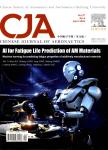Nonlinear dynamics of a flapping rotary wing:Modeling and optimal wing kinematic analysis
Nonlinear dynamics of a flapping rotary wing:Modeling and optimal wing kinematic analysis作者机构:School of Aerospace Beijing Institute of Technology Centre for Aeronautics SATM Cranfield University
出 版 物:《Chinese Journal of Aeronautics》 (中国航空学报(英文版))
年 卷 期:2018年第31卷第5期
页 面:1041-1052页
核心收录:
学科分类:08[工学] 0802[工学-机械工程] 0825[工学-航空宇航科学与技术] 0801[工学-力学(可授工学、理学学位)]
主 题:Dynamic model Dynamic time-lag Flapping rotary wing Kinematics of wings Passive rotation Strike angle
摘 要:The analysis of the passive rotation feature of a micro Flapping Rotary Wing(FRW)applicable for Micro Air Vehicle(MAV) design is presented in this paper. The dynamics of the wing and its influence on aerodynamic performance of FRW is studied at low Reynolds number(~10~3).The FRW is modeled as a simplified system of three rigid bodies: a rotary base with two flapping wings. The multibody dynamic theory is employed to derive the motion equations for FRW. A quasi-steady aerodynamic model is utilized for the calculation of the aerodynamic forces and moments. The dynamic motion process and the effects of the kinematics of wings on the dynamic rotational equilibrium of FWR and the aerodynamic performances are studied. The results show that the passive rotation motion of the wings is a continuous dynamic process which converges into an equilibrium rotary velocity due to the interaction between aerodynamic thrust, drag force and wing inertia. This causes a unique dynamic time-lag phenomena of lift generation for FRW, unlike the normal flapping wing flight vehicle driven by its own motor to actively rotate its wings. The analysis also shows that in order to acquire a high positive lift generation with high power efficiency and small dynamic time-lag, a relative high mid-up stroke angle within 7–15° and low mid-down stroke angle within -40° to -35° are necessary. The results provide a quantified guidance for design option of FRW together with the optimal kinematics of motion according to flight performance requirement.



